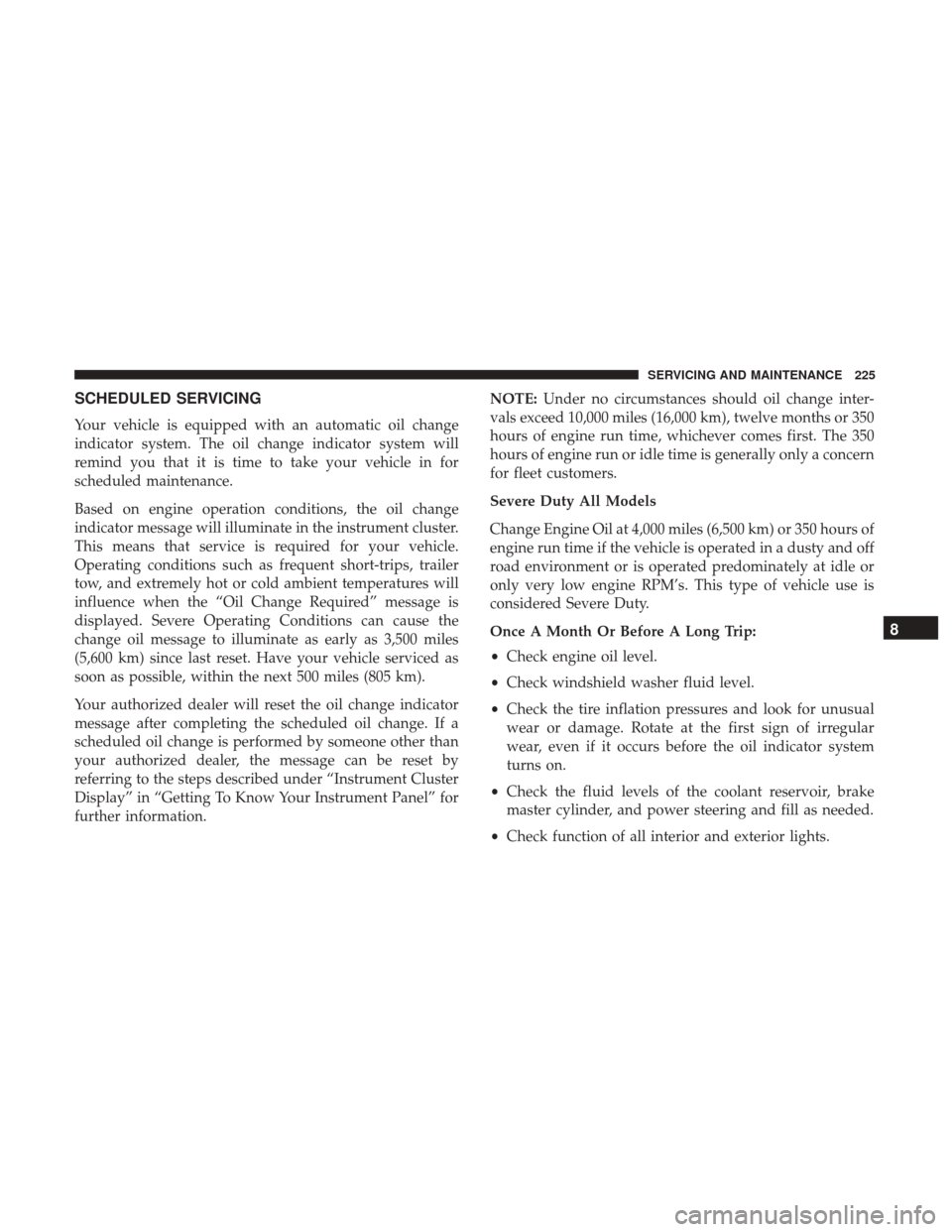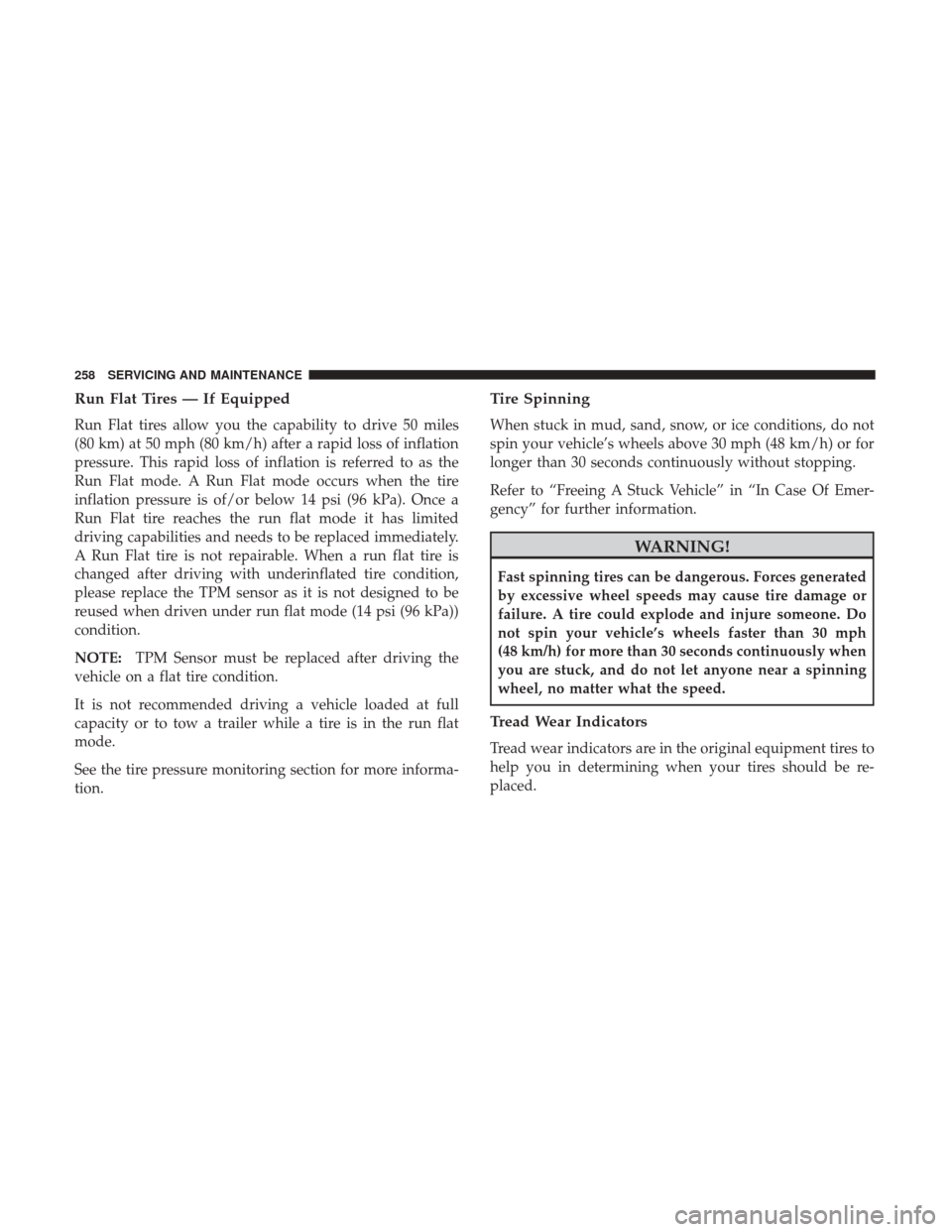Trailer Ram ProMaster 2019 Owner's Guide
[x] Cancel search | Manufacturer: RAM, Model Year: 2019, Model line: ProMaster, Model: Ram ProMaster 2019Pages: 332, PDF Size: 3.66 MB
Page 227 of 332

SCHEDULED SERVICING
Your vehicle is equipped with an automatic oil change
indicator system. The oil change indicator system will
remind you that it is time to take your vehicle in for
scheduled maintenance.
Based on engine operation conditions, the oil change
indicator message will illuminate in the instrument cluster.
This means that service is required for your vehicle.
Operating conditions such as frequent short-trips, trailer
tow, and extremely hot or cold ambient temperatures will
influence when the “Oil Change Required” message is
displayed. Severe Operating Conditions can cause the
change oil message to illuminate as early as 3,500 miles
(5,600 km) since last reset. Have your vehicle serviced as
soon as possible, within the next 500 miles (805 km).
Your authorized dealer will reset the oil change indicator
message after completing the scheduled oil change. If a
scheduled oil change is performed by someone other than
your authorized dealer, the message can be reset by
referring to the steps described under “Instrument Cluster
Display” in “Getting To Know Your Instrument Panel” for
further information.NOTE:
Under no circumstances should oil change inter-
vals exceed 10,000 miles (16,000 km), twelve months or 350
hours of engine run time, whichever comes first. The 350
hours of engine run or idle time is generally only a concern
for fleet customers.
Severe Duty All Models
Change Engine Oil at 4,000 miles (6,500 km) or 350 hours of
engine run time if the vehicle is operated in a dusty and off
road environment or is operated predominately at idle or
only very low engine RPM’s. This type of vehicle use is
considered Severe Duty.
Once A Month Or Before A Long Trip:
• Check engine oil level.
• Check windshield washer fluid level.
• Check the tire inflation pressures and look for unusual
wear or damage. Rotate at the first sign of irregular
wear, even if it occurs before the oil indicator system
turns on.
• Check the fluid levels of the coolant reservoir, brake
master cylinder, and power steering and fill as needed.
• Check function of all interior and exterior lights.
8
SERVICING AND MAINTENANCE 225
Page 254 of 332

Tire And Loading Information Placard
This placard tells you important information about the:
1. Number of people that can be carried in the vehicle.
2. Total weight your vehicle can carry.
3. Tire size designed for your vehicle.
4. Cold tire inflation pressures for the front, rear, and sparetires.Loading
The vehicle maximum load on the tire must not exceed the
load carrying capacity of the tire on your vehicle. You will
not exceed the tire’s load carrying capacity if you adhere to
the loading conditions, tire size, and cold tire inflation
pressures specified on the Tire and Loading Information
placard in “Vehicle Loading” in the “Starting And Operat-
ing” section of this manual.
NOTE: Under a maximum loaded vehicle condition, gross
axle weight ratings (GAWRs) for the front and rear axles
must not be exceeded.
For further information on GAWRs, vehicle loading, and
trailer towing, refer to “Vehicle Loading” in the “Starting
And Operating” section of this manual.
To determine the maximum loading conditions of your
vehicle, locate the statement “The combined weight of
occupants and cargo should never exceed XXX kg or
XXX lbs” on the Tire and Loading Information placard. The
combined weight of occupants, cargo/luggage and trailer
tongue weight (if applicable) should never exceed the
weight referenced here.
Tire And Loading Information Placard
252 SERVICING AND MAINTENANCE
Page 255 of 332

Steps For Determining Correct Load Limit—
(1) Locate the statement “The combined weight of
occupants and cargo should never exceed XXX kg or
XXX lbs.” on your vehicle’s placard.
(2) Determine the combined weight of the driver and
passengers that will be riding in your vehicle.
(3) Subtract the combined weight of the driver and
passengers from XXX kg or XXX lbs.
(4) The resulting figure equals the available amount of
cargo and luggage load capacity. For example, if “XXX”
amount equals 1400 lbs. and there will be five 150 lb
passengers in your vehicle, the amount of available
cargo and luggage load capacity is 650 lbs. (1400-750
(5x150) = 650 lbs.)
(5) Determine the combined weight of luggage and
cargo being loaded on the vehicle. That weight may not
safely exceed the available cargo and luggage load
capacity calculated in Step 4.
(6) If your vehicle will be towing a trailer, load from
your trailer will be transferred to your vehicle. Consultthis manual to determine how this reduces the available
cargo and luggage load capacity of your vehicle.
Metric Example For Load Limit
For example, if “XXX” amount equals 635 kg and there will
be five 68 kg passengers in your vehicle, the amount of
available cargo and luggage load capacity is 295 kg (635-
340 (5x68) = 295 kg) as shown in step 4.
NOTE:
•
If your vehicle will be towing a trailer, load from your
trailer will be transferred to your vehicle. The following
table shows examples on how to calculate total load,
cargo/luggage, and towing capacities of your vehicle
with varying seating configurations and number and
size of occupants. This table is for illustration purposes
only and may not be accurate for the seating and load
carry capacity of your vehicle.
• For the following example, the combined weight of
occupants and cargo should never exceed 865 lbs
(392 kg).
8
SERVICING AND MAINTENANCE 253
Page 260 of 332

Run Flat Tires — If Equipped
Run Flat tires allow you the capability to drive 50 miles
(80 km) at 50 mph (80 km/h) after a rapid loss of inflation
pressure. This rapid loss of inflation is referred to as the
Run Flat mode. A Run Flat mode occurs when the tire
inflation pressure is of/or below 14 psi (96 kPa). Once a
Run Flat tire reaches the run flat mode it has limited
driving capabilities and needs to be replaced immediately.
A Run Flat tire is not repairable. When a run flat tire is
changed after driving with underinflated tire condition,
please replace the TPM sensor as it is not designed to be
reused when driven under run flat mode (14 psi (96 kPa))
condition.
NOTE:TPM Sensor must be replaced after driving the
vehicle on a flat tire condition.
It is not recommended driving a vehicle loaded at full
capacity or to tow a trailer while a tire is in the run flat
mode.
See the tire pressure monitoring section for more informa-
tion.
Tire Spinning
When stuck in mud, sand, snow, or ice conditions, do not
spin your vehicle’s wheels above 30 mph (48 km/h) or for
longer than 30 seconds continuously without stopping.
Refer to “Freeing A Stuck Vehicle” in “In Case Of Emer-
gency” for further information.
WARNING!
Fast spinning tires can be dangerous. Forces generated
by excessive wheel speeds may cause tire damage or
failure. A tire could explode and injure someone. Do
not spin your vehicle’s wheels faster than 30 mph
(48 km/h) for more than 30 seconds continuously when
you are stuck, and do not let anyone near a spinning
wheel, no matter what the speed.
Tread Wear Indicators
Tread wear indicators are in the original equipment tires to
help you in determining when your tires should be re-
placed.
258 SERVICING AND MAINTENANCE
Page 322 of 332

Fluids And Lubricants...................... .282
Fog Lights ................................40
Fold-Flat Seats .............................23
Four-Way Hazard Flasher .....................179
Freeing A Stuck Vehicle ..................... .219
Fuel ................................... .278
Additives ............................. .279
Clean Air ............................. .278
Ethanol .............................. .279
Filler Cap (Gas Cap) ..................... .160
Gasoline .............................. .278
Materials Added ........................ .279
Methanol ............................. .279
Octane Rating ....................... .278, 282
Requirements ....................... .278, 282
Tank Capacity .......................... .282
Fuses .................................. .186
Gas Cap (Fuel Filler Cap) .................160, 161
Gasoline, Clean Air ........................ .278
Gasoline, Reformulated ..................... .278
Gear Ranges ............................. .143
Gear Selector Override ...................... .218
General Information .........................99
Glass Cleaning ........................... .273Gross Axle Weight Rating
.................162, 164
Gross Vehicle Weight Rating ...............162, 163
Guide Body Builders ............................5
GVWR ................................. .162
Hazard Driving Through Flowing, Rising, Or Shallow Standing
Water ................................ .175
Hazard Warning Flashers .....................179
Headlights Cleaning .............................. .270
High Beam ..............................39
High Beam/Low Beam Select Switch ...........39
Passing ................................40
Switch .................................39
Head Restraints ............................32
Heated
Mirrors .............................38
Heated Seats ...............................29
Heater, Engine Block ....................... .138
High Beam/Low Beam Select (Dimmer) Switch ......39
Hill Start Assist .............................94
Hitches Trailer Towing .......................... .166
Hood Prop ................................55
320 INDEX
Page 327 of 332

Signals, Turn.......................... .82, 133
Snow Chains (Tire Chains) ....................266
Snow Tires .............................. .262
Spare Tires ........................ .262, 263, 264
Spark Plugs ............................. .282
Speed Control (Cruise Control) .................151
Starting ................................ .137
Automatic Transmission ....................137
Button .................................18
Cold Weather .......................... .137
Engine Fails To Start ..................... .137
Steering ..................................34
Column Lock ............................34
Power ............................ .149, 150
Steering Wheel Audio Controls .................298
Storage, Vehicle ........................ .51, 269
Storing Your Vehicle ....................... .269
Supplemental Restraint System – Air Bag ..........112
Sway Control, Trailer .........................93
Synthetic Engine Oil ....................... .233
Telescoping Steering Column ...................34
Tire And Loading Information Placard ............251
Tire Markings ............................ .246
Tires......................... .133, 254, 262, 267Aging (Life Of Tires)
..................... .259
Air Pressure ........................... .254
Chains ............................... .266
Changing .......................... .194, 245
Compact Spare ......................... .263
General Information ...................254, 262
High Speed ............................ .257
Inflation Pressure ....................... .256
Jacking ........................... .194, 245
Life Of Tires ........................... .259
Load Capacity ...................... .251, 252
Pressure Monitoring System (TPMS) .........77, 95
Quality Grading ........................ .267
Radial ............................... .257
Replacement ........................... .260
Rotation .............................. .267
Safety ............................ .245,
254
Sizes ................................ .247
Snow Tires ............................ .262
Spare Tires ......................... .262, 264
Spinning .............................. .258
Trailer Towing .......................... .169
Tread Wear Indicators .....................258
Wheel Nut Torque ....................... .276
Tire Safety Information ...................... .245
12
INDEX 325
Page 328 of 332

Tire Service Kit...............206, 207, 209, 211, 213
Tongue Weight/Trailer Weight .................167
To Open Hood .............................55
Torque Converter Clutch .....................149
Towing ............................. .163, 220
Disabled Vehicle ........................ .220
Guide ................................ .166
Recreational ........................... .173
Weight ............................... .166
Towing Behind A Motorhome ..................173
Traction ................................ .174
Traction Control ............................89
Trailer Sway Control (TSC) ....................93
Trailer Towing ............................ .163
Cooling System Tips ..................... .172
Hitches ............................... .166
Minimum Requirements ....................168
Tips ................................. .171
Trailer And Tongue Weight ..................167
Wiring ............................... .170
Trailer Towing Guide ....................... .166
Trailer Weight ............................ .166
Transmission Automatic ......................... .141, 244
Fluid ................................ .284Maintenance
........................... .244
Transporting Pets ......................... .129
Tread Wear Indicators ...................... .258
Turn Signals ...............................82
Uconnect Uconnect Settings .........................17
Uconnect Settings Customer Programmable Features .............287
Uconnect Voice Command ....................302
Uniform Tire Quality Grades ..................267
Unleaded Gasoline ........................ .278
Untwisting Procedure, Seat Belt ................106
USB................................... .298
Vehicle Certification Label ....................161
V
ehicle Identification Number (VIN) .............276
Vehicle Loading .....................161, 163, 252
Vehicle Modifications/Alterations .................6
Vehicle Storage ......................... .51, 269
Viscosity, Engine Oil ....................... .232
Voice Command .......................... .302
Warning Lights (Instrument Cluster Descriptions) ....79
Warnings And Cautions .......................5
326 INDEX